unit5 Do you have a soccer ball英语说讲课
Unit5Doyouhaveasoccerball_SectionA1a-1c说课稿2023-202

Unit 5 Do you have a soccer ball?Section A 1a1cGood morning,dear judges! Today, it's my honor to be here to share my teaching ideas with all of you. My name is Bi Miaomiao. I e from Huhe Branch School.I will introduce my topic from eight parts: analysis of teaching material, analysis of students, learning objectives, teaching focus and difficulties, teaching and learning methods, teaching procedures, blackboard design and teaching reflection.Part 1 Analysis of teaching materialThe topic is taken from PEP, Go for it, the first book of Grade 7,Unit 5 Do you have a soccer ball? Section A 1a1c.’s a listening and speaking lesson about sports and ownership. It’s interesting and practical. Students can use the new words and sentences to municate with others in their daily life.Part 2 Analysis of studentsStudents of Grade Seven have learned English for many years and have some certain abilities of imagination, observation and creation. But they are short of vocabularies. Also, they have some difficulties in expressing themselves in English. However, they are interested in new things and have a strong thirst for knowledge. In this lesson, students can learn new words about sports and structures about ownership, which canimprove their language abilities.Part 3 Learning objectivesBased on the above analysis and the demands of new curriculum standard of 2022, there are four objectives.The first is language petence. Students can read new words such as soccer ball, volleyball and so on. They can also use the structure “Do you have a soccer ball? Yes, I do/No, I don’t” to talk about ownership.The second is learning petence. Students can understand the meaning of the target language and improve their listening and speaking skills. The third is thinking qualities. Students can use pictures, videos and objects to memorize words and expressions. The fourth is cultural awareness.They can know more about different cultures and learn to respect cultural diversity.Part 4 Teaching focus and difficultiesThe focus is to master words, phrases and sentences. The difficulties are to conduct the tasks step by step and use the target knowledge to make conversations.Part 5 Teaching and learning methodsThe teaching model is PWP. The teaching methods include situational teaching method, taskbased language teaching method, audiolingual method and independent inquiry. Students can use cooperative and exploratory learning methods. In my opinion, teaching and learning are interactions.Part 6 Teaching proceduresStep 1 Lead in (3 minutes)I greet students and make a brief selfintroduction as a P.E. and English teacher. I will give students some instructions to have a P.E. class. It can draw students’attention, arouse their interests and lead into the topic.Step 2 Prlistening (8 minutes)It mainly deals with words. I use pictures, videos and games . Then ask students to finish 1a and check the answers. This step can help students learn the target words and phrases. It can also reduce the difficulties for the following steps.Step 3 Whilelistening (4 minutes)Step 3 is about listening. Two tasks are designed to help train students’ listening skills and let students get familiar with the target sentences.Step 4 Postlistening (15 minutes)Let students practice the conversation in 1c to develop their abilities of speaking. Make their own conversations in pairs. I invite several pairs to perform to increase their awareness of cooperation. What’s more, a chant and some exercises can help them strengthen what they learned in this lesson. Practice makes perfect.Step 5 Summary (4 minutes)I make a summary to rethink what they have learned in this class. And I will give value guidance to lead students to have a healthy life. Step 6 Homework (1 minute)There are two kinds of homework: required and optional homework. Students’ability of learning and using English will be improved. They will get more practice and review after class.Part 7 Blackboard designU5 Do you have a soccer ball?Section A (1a1c)By looking at the blackboard, it’s helpful for students to get the main content of this lesson clearly.Part 8 Teaching reflectionAfter this class, I will make reflections to promote better teaching and learning.。
人教版英语七上 U5 Do you have a soccer ball 讲义

Unit5 Do you have a soccer ball?一、重点词汇及拓展1. have v.(1) 有e.g. I have a pen. 我有一只钢笔。
(2) 吃;喝e.g. I have breakfast every day. 我每天吃早饭。
(3) 经历e.g. have a good time 玩得开心;过得愉快(4) 上课e.g. We have English lessons every day. 我们每天上英语课。
(5) 举办e.g. Mark has a party. 马克举办了一个派对。
(6) 得…病e.g. He has a cold and a headache. 他感冒和头疼。
2. let v.允许;让let’s = let us 让我们let sb. do sth. 让某人做某事let sb. not do sth. 让某人不要做某事e.g. Let’s have a party tonight! 让我们今晚举办一个派对吧!make sb. do sth. 使某人做某事e.g. The movie makes me miss my mother. 这部电影使我怀念我的妈妈。
3. go v.去;走go to +地点去某地go to school 去学校go here/there/home 去这儿/去那/回家go shopping 去购物go swimming 去游泳go hiking 去远足go skating 去轮滑go boating 去划船4. lateadj. 迟的;晚的be late for school 上学迟到be late for class 上课迟到1be late for work 上班迟到adv. 迟地;晚地later adv. 后来;以后e.g. Three days later, he found his father. (句中有段时间+later,句子用一般过去时)三天后,他找到了他的爸爸。
Unit5 Do you have a soccer ball说课稿
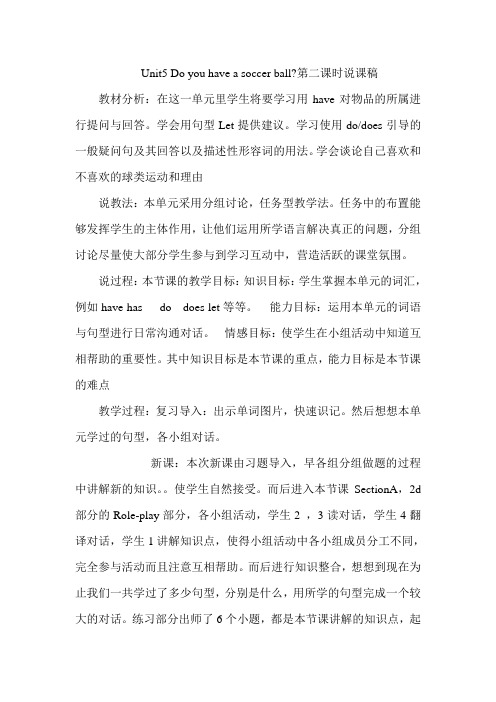
Unit5 Do you have a soccer ball?第二课时说课稿教材分析:在这一单元里学生将要学习用have对物品的所属进行提问与回答。
学会用句型Let提供建议。
学习使用do/does引导的一般疑问句及其回答以及描述性形容词的用法。
学会谈论自己喜欢和不喜欢的球类运动和理由说教法:本单元采用分组讨论,任务型教学法。
任务中的布置能够发挥学生的主体作用,让他们运用所学语言解决真正的问题,分组讨论尽量使大部分学生参与到学习互动中,营造活跃的课堂氛围。
说过程:本节课的教学目标:知识目标:学生掌握本单元的词汇,例如have has do does let等等。
能力目标:运用本单元的词语与句型进行日常沟通对话。
情感目标:使学生在小组活动中知道互相帮助的重要性。
其中知识目标是本节课的重点,能力目标是本节课的难点教学过程:复习导入:出示单词图片,快速识记。
然后想想本单元学过的句型,各小组对话。
新课:本次新课由习题导入,早各组分组做题的过程中讲解新的知识。
使学生自然接受。
而后进入本节课SectionA,2d 部分的Role-play部分,各小组活动,学生2 ,3读对话,学生4翻译对话,学生1讲解知识点,使得小组活动中各小组成员分工不同,完全参与活动而且注意互相帮助。
而后进行知识整合,想想到现在为止我们一共学过了多少句型,分别是什么,用所学的句型完成一个较大的对话。
练习部分出师了6个小题,都是本节课讲解的知识点,起到巩固的作用。
作业部分记忆本节课单词,病自己独立完成编对话任务。
这就是本节课的说课内容,在整节课当中还有许多不成熟的地方,请大家提出宝贵意见。
unit 5 Do you have a soccer ball全单元教学课件

A: Let’s play soccer. B: That sounds good.
A: Let’s play soccer. B: I don’t have a soccer ball. A: Well, let’s play volleyball. B: That sounds good.
Do you like the sport?
But I don’t I have … have …
I have a job. I have a brother. I have a sister. I have a computer.
But I don’t have a car.
She has a cat. She has some beautiful clothes. She has … But she doesn’t have…
play basketball play baseball play volleyball
play tennis play soccer
play ping-pong
1a Match the words with the things in the picture.
1. tennis ball ___ a c 3. soccer ball ___ d 5. basketball ___
A: Do you have a soccer ball? B: Yes. I do. A: Where is the soccer ball? B: It’s on the floor.
Let’s survey!
We want to have a ball game. What kind of balls do you have?
《英语七年级上Unit 5 Do you have a soccer ball?》课件

While-reading
Scanning Read the survey results again and answer the questions.
1. Where do Frank and his brother play soccer? _A_t_s_c_h_o_o_l._/T__h_ey__p_l_ay__s_o_c_ce_r__at_s_c_h_o_o_l_. _____
1) 介词“和……在一起” I live with my parents. 我和我的父母住在一起。
2) 介词“带有”
He is a boy with black hair. 他是一个黑头发的男孩。
3) 介词“使用”
We can see with our eyes. 我们可以用眼睛看。
Post-reading
《英语七年级上Unit 5 Do you have a soccer ball?》
Warming up
Quick eyes What’s this in English?
Warming up
Free talk Do you like sports? What sports things do you have?
volleyballs, four basketballs and five classmates. 班级; 课
同班同学
Post-reading
Language points
1. I don’t have a soccer ball, but my brother Alan does. (教材P29 2b)
Language points
4. I love sports, but I don’t play them — I only watch them on TV! (教材P29 2b)
Unit5DoyouhaveasoccerballPeriod1SectionA(1a~1c)说课稿
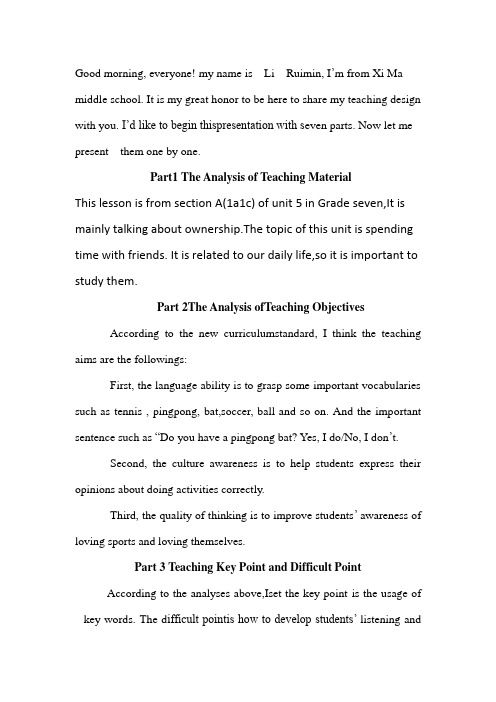
Good morning, everyone! my name is Li Ruimin, I’m from Xi Ma middle school. It is my great honor to be here to share my teaching design with you. I’d like to begin thispresentation with s even parts. Now let me present them one by one.Part1 The Analysis of Teaching MaterialThis lesson is from section A(1a1c) of unit 5 in Grade seven,It is mainly talking about ownership.The topic of this unit is spending time with friends. It is related to our daily life,so it is important to study them.Part 2The Analysis ofTeaching ObjectivesAccording to the new curriculumstandard, I think the teaching aims are the followings:First, the language ability is to grasp some important vocabularies such as tennis , pingpong, bat,soccer, ball and so on. And the important sentence such as “Do you have a pingpong bat? Yes, I do/No, I don’t.Second, the culture awareness is to help students express their opinions about doing activities correctly.Third, the quality of thinking is to improve students’ awareness of loving sports and loving themselves.Part 3 Teaching Key Point and Difficult PointAccording to the analyses above,Iset the key point is the usage of key words. The d ifficult pointis how to develop students’ listening andspeaking skills..Part4 The Analysis of StudentsThe students in Grade seven have got some basic English, they are eager to learn, eager to show. But some of them have no enough bravery to speak English.. So it is important for the teacher to help them open their mouth to speak English.Part 5 Teaching MethodsBased on the content, I mainly adopt different teaching methods. For example,municative teaching method,Taskbased teaching method and cooperative learning approach. At the same time, I encourage students to finish the task actively. Give the class to the students and let them feel they are the masters of the class.Part 6 Teaching ProceduresIn this part, I have seven steps to say.Step1.LeadinAt the beginning of the class, I show a video to the students. Beforewatching it, I ask a question “How many kinds of sports are there in the video?” The Purpose of my designis to lead in the topic and catch students' attention about the topic.Step 2. PresentationFirst, I show some pictures on the flash, ask students to read the new words for several times. Then do a game “quick eyes”and a match toconsolidate these words. Next, ask the students to finish the exercises in 1a. After checking the answers, let them read the dialogue on the picture. Finally ask the students to make their own dialogues and act them out. The purpose is to help students to grasp important words and the basic sentence.Step 3. ListeningLet the students listen carefully and circle the words they hear, then check the answer. Next , read the dialogue in 1c together. Pay attention to pronunciation and intonation. It aims to improve the students’listening and reading abilities .Step 4. PracticeIn order to consolidate the key words and the important sentence, the teacher design three activities.First, show some pictures and the sentence structure on the flash, according to the information, let some students ask questions,the others answer .Then, do Pair work. When the students are ready, let some of them show their dialogues in front of the class. Claps will be rewarded to good performers.Step 5. SummarySummarize the key words and the important sentence , let the students read again. Later let them know the benefit of sports. The purpose is to improve these teenagers’ awareness of loving sports.Step 6. HomeworkLet the students write some sports things they have . It helps them grasp the content better.Step 7. Black designUnit 5 Do you have a soccer ball?.—Do you have a pingpong bat?Yes, I do.Do you have a pingpong ball?No, I don’t.Part 7 Teaching ReflectionsIn my opinion, it is successful. My reasons are as follows:Firstly, the teaching objectives are quite clear. All the activities are focused on the theme.Secondly, the teacher promotes students’motivation and arouse students’ interestto learn English.That’s all! Thanks for your listening.。
新unit5doyouhaveasoccerball全英教案培训课件
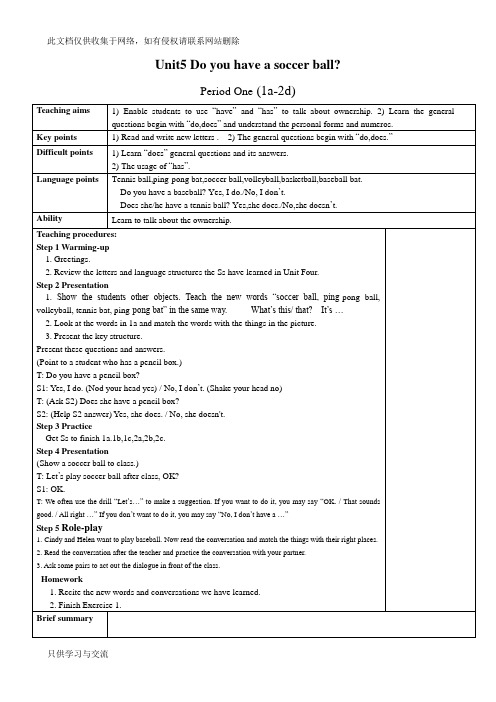
S1: Yes, I do. (Nod your head yes)/ No, I don’t. (Shake your head no)
T: (Ask S2) Does sheபைடு நூலகம்have a pencil box?
S2: (Help S2 answer) Yes, she does./ No, she doesn't.
Key points
1)Read and write new letters. 2)The general questions begin with“do,does.”
Difficult points
1) Learn“does”general questions and its answers.
2)The usage of“has”.
Ability
Learn to talk about the ownership.
Teaching procedures:
Step 1 Warming-up
1. Greetings.
2. Review the letters and language structuresthe Ss have learned in Unit Four.
Step 3 Practice
Get Ss to finish1a.1b,1c,2a,2b,2c.
Step 4Presentation
(Show a soccer ball to class.)
T: Let’s play soccer ball after class, OK?
S1: OK.
T: We often use the drill“Let’s…”to make a suggestion. If you want to do it, you may say“OK. / That sounds good. / All right…”If you don’t want to do it, you may say“No, I don’t have a…”
人教版七年级上册英语讲义 Unit 5 Do you have a soccer ball

Unit5 Do you have a soccer ball?讲义一、【重点单词】do /du:/助动词,帮助构成一般现在时的否定句或疑问句,无意义;实义动词“做,干”have /hæv/有tennis /'tenɪs/网球ball /bɔ:l/球ping-pong乒乓球bat /bæt/球棒;球拍soccer /'sɑ:kər/,/'sɒkə/(英式)足球soccer ball(英式)足球volleyball /'vɒlɪbɔ:l/排球basketball /'bɑ:skɪtbɔ:l/篮球let /let/允许;让us /ʌs/ (we的宾格)我们let's = let us让我们(一起)go /ɡəʊ/去;走we /wi:/我们late /leɪt/迟到has /hæz/有(have的第三人称单数形式)get /ɡet/去取(或带来);得到great /ɡreɪt/美妙的;伟大的play /pleɪ/参加(比赛或运动);玩耍sound /saʊnd/听起来好像interesting /'ɪntrəstɪŋ/有趣的;使人快乐的;乐趣;快乐difficult /'dɪfɪkəlt/困难的relaxing /rɪ'læksɪŋ/轻松的;令人放松的watch /wɒʧ/注视;观看TV /,ti:'vi:/电视same /seɪm/相同的love /lʌv/爱;喜爱with /wɪð/和...在一起;带有;使用sport /spɔ:(r)t/体育运动them /ðem/ /ðəm/他(她、它)们only /'əʊnlɪ/只;仅like /laɪk/喜欢;喜爱easy /'i:zi/容易的;不费力的after /'ɑ:ftə/在...之后class /klɑ:s/班级;课classmate /'klɑ:smeɪt/同班同学二、【重点短语】1. have a volleyball 有一个排球2. play volleyball/tennis 打排球/网球3. have a ping-pong/table tennis 有一个乒乓球4. play ping-pong/table tennis 打乒乓球5. with our friends 和我们的朋友一起6. have a football/soccer ball 有一个足球7. play football/soccer 踢足球8. at school 在校,在上学9. play sports 做运动10. play computer games 玩电脑游戏11. watch TV 看电视12. in the same school 在同一所学校13. after class 下课后14. go to school 去上学三、【重点句型】1. —Do you have a ping-pong bat? 你有一个乒乓球拍吗?—No, I don’t. 不,我没有。
unit5doyouhaveasoccerball说课稿
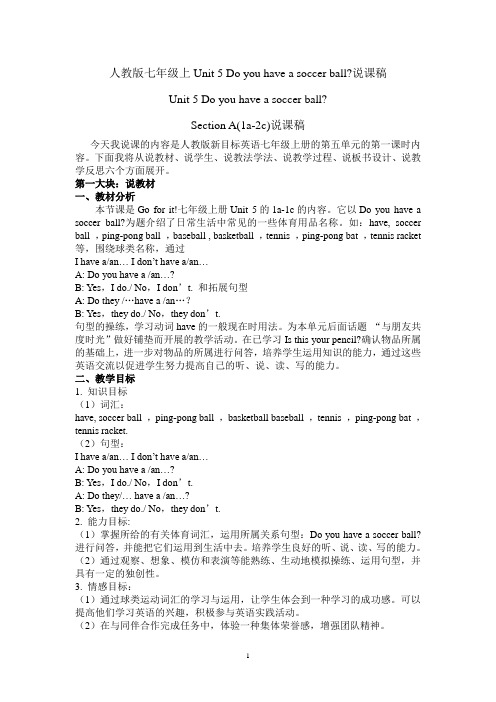
人教版七年级上Unit 5 Do you have a soccer ball?说课稿Unit 5 Do you have a soccer ball?Section A(1a-2c)说课稿今天我说课的内容是人教版新目标英语七年级上册的第五单元的第一课时内容。
下面我将从说教材、说学生、说教法学法、说教学过程、说板书设计、说教学反思六个方面展开。
第一大块:说教材一、教材分析本节课是Go for it!七年级上册Unit 5的1a-1c的内容。
它以Do you have a soccer ball?为题介绍了日常生活中常见的一些体育用品名称。
如:have, soccer ball ,ping-pong ball ,baseball , basketball ,tennis ,ping-pong bat ,tennis racket 等,围绕球类名称,通过I have a/an… I don’t have a/an…A: Do you have a /an…?B: Yes,I do./ No,I don’t. 和拓展句型A: Do they /…have a /an…?B: Yes,they do./ No,they don’t.句型的操练,学习动词have的一般现在时用法。
为本单元后面话题“与朋友共度时光”做好铺垫而开展的教学活动。
在已学习Is this your pencil?确认物品所属的基础上,进一步对物品的所属进行问答,培养学生运用知识的能力,通过这些英语交流以促进学生努力提高自己的听、说、读、写的能力。
二、教学目标1. 知识目标(1)词汇:have, soccer ball ,ping-pong ball ,basketball baseball ,tennis ,ping-pong bat ,tennis racket.(2)句型:I have a/an… I don’t have a/an…A: Do you have a /an…?B: Yes,I do./ No,I don’t.A: Do they/… have a /an…?B: Yes,they do./ No,they don’t.2. 能力目标:(1)掌握所给的有关体育词汇,运用所属关系句型:Do you have a soccer ball?进行问答,并能把它们运用到生活中去。
人教版英语七年级上册Unit5Doyouhaveasoccerball说课稿

人教版英语七年级上册Unit 5 Do you have a soccer ball说课稿一. 教材分析人教版英语七年级上册Unit 5 Do you have a soccer ball是一篇以询问和描述物品为主题的课文。
本节课的主要内容是让学生掌握一般现在时态的疑问句和回答,以及学会使用have作为实义动词的用法。
通过对课文的学习,学生能够提高自己的听说能力和交际能力。
二. 学情分析针对七年级的学生,他们对英语已经有了一定的了解和掌握,但仍有部分学生对英语学习存在恐惧心理,学习积极性不高。
针对这一情况,教师需要在教学过程中注重激发学生的学习兴趣,提高他们的学习积极性。
此外,学生在本节课需要掌握一般现在时态的疑问句和回答,以及实义动词have的用法,这对他们来说是一个新的知识点,需要在教学中进行重点讲解和练习。
三. 说教学目标1.知识目标:学生能够掌握一般现在时态的疑问句和回答,以及实义动词have的用法。
2.能力目标:学生能够听懂、会说本节课的主要句型,提高自己的听说能力。
3.情感目标:通过本节课的学习,学生能够激发对英语学习的兴趣,提高自己的学习积极性。
四. 说教学重难点1.重点:一般现在时态的疑问句和回答,实义动词have的用法。
2.难点:一般现在时态的疑问句和回答的运用,实义动词have在不同语境中的用法。
五. 说教学方法与手段1.采用情境教学法,通过设定生活情境,让学生在实际语境中学习英语。
2.运用任务型教学法,让学生在完成任务的过程中,巩固所学知识。
3.采用分组合作学习,提高学生的团队协作能力和交际能力。
4.利用多媒体教学手段,如PPT、视频等,丰富教学内容,提高学生的学习兴趣。
六. 说教学过程1.导入:通过问答方式,引导学生复习一般现在时态的肯定句和否定句。
2.新课呈现:展示课文图片,引导学生回答问题,引入本节课的主题。
3.课堂讲解:讲解一般现在时态的疑问句和回答,以及实义动词have的用法。
Unit5 Do you have a soccer ball 全单元授课教案(4课时)
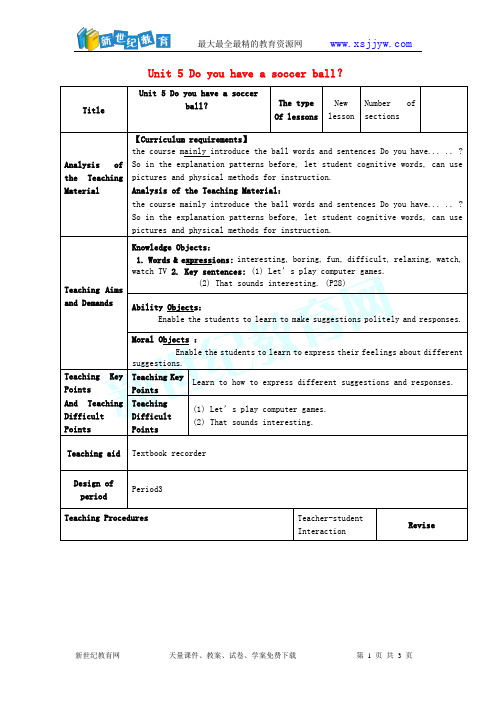
Ask the students to say out the answers. Go around the room, asking students to point to a picture and say the word that goes with that picture. The answers are: 1. c; 2. d; 3. e; 4. b; 5. a.
Teaching Key Points
And Teaching Difficult Points
Teaching Key Points
Learn to how to express different suggestions and responses.
Teaching Difficult Points
Teaching Aims and Demands
Knowledge Objects:
1.Words & expressions:interesting, boring, fun, difficult, relaxing, watch, watch TV2. Key sentences:(1)Let’s play computer games.
Analysis of the Teaching Material:
the course mainly introduce the ball words and sentences Do you have... .. ? So in the explanation patterns before, let student cognitive words, can use pictures and physical methods for instruction.
七年级英语上册 Unit 5 Do you have a soccer ball讲义 (新版)人教新
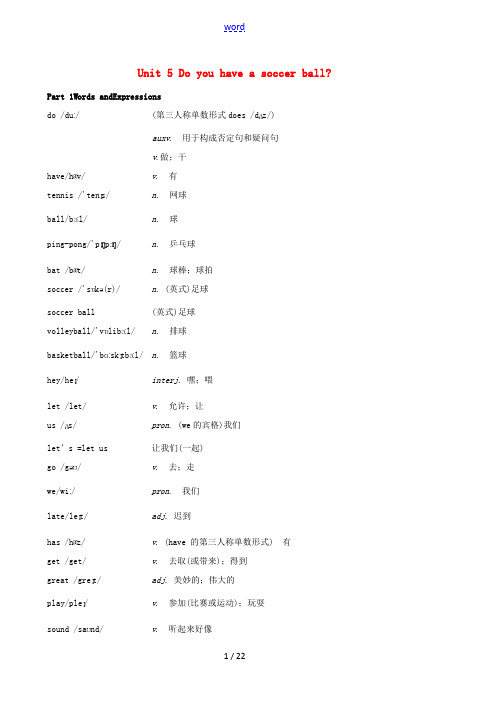
Unit 5 Do you have a soccer ball? Part 1Words andExpressionsdo /duː/ (第三人称单数形式does /dʌz/)auxv. 用于构成否定句和疑问句v.做;干have/hæv/ v. 有tennis /'tenɪs/ n. 网球ball/bɔːl/ n. 球ping-pong/'pɪŋpɔŋ/ n. 乒乓球bat /bæt/ n. 球棒;球拍soccer /'sɒkə(r)/ n. (英式)足球soccer ball (英式)足球volleyball/'vɒlibɔːl/ n. 排球basketball/'bɑːskɪtbɔːl/ n. 篮球hey/heɪ/ interj. 嘿;喂let /let/ v. 允许;让us /ʌs/ pron. (we的宾格)我们let’s =let us 让我们(一起)go /gəʊ/ v. 去;走we/wiː/ pron. 我们late/leɪt/ adj. 迟到has /hæz/ v. (have 的第三人称单数形式) 有get /get/ v. 去取(或带来);得到great /greɪt/ adj. 美妙的;伟大的play/pleɪ/ v. 参加(比赛或运动);玩耍sound /saʊnd/ v. 听起来好像interesting/'ɪntrəstɪŋ/ adj. 有趣的boring/'bɔːrɪŋ/ adj. 没趣的;令人厌倦的fun /fʌn/ adj. 有趣的;使人快乐的n. 乐趣;快乐difficult/'dɪfɪkəlt/ adj. 困难的relaxing/rɪ'læksɪŋ/ adj. 轻松的;令人放松的watch /wɒtʃ/ v. 注视;观看TV/,tiː'viː/ n. (=television /'telɪvɪʒn/)电视;电视机watchTV 看电视same /seɪm/ adj. 相同的love /lʌv/ v.&n. 爱;喜爱with /wɪð/ prep. 和……在一起;带有;使用sport /spɔː(r)t/ n. 体育运动them /ðəm/ pron. (they的宾格) 他(她、它)们only/'əʊnli/ adv. 只;仅like/laɪk/ v. 喜欢;喜爱easy/'iːzi/ adj. 容易的;不费力的after /'ɑːftə(r)/ prep.&conj. 在……之后class /klɑːs/ n. 班级;课classmate/'klɑːsmeɪt/ n. 同班同学Bill /bɪl/ 比尔(男名)Part 2:Texts课文(一)Cindy: Hey, Helen, let’sgo!We’relate!Helen: OK.Cindy: Doyou havethe baseball?Helen: Yes,Ido.It’s in mybag.Cindy: And where’s our baseballbat?Helen: Billhas it.Cindy: Oh,yeah.And doyou haveyour jacket? Helen:Oh, no,Idon’t.It’s on the chair.Let megetit. Cindy: Andyour hat, too!Helen: OK,Ihavemyjacket and hat.Let’sgo!Structure1. Doyou haveabaseball?Yes,Ido./No,Idon’t.Ihaveavolleyball.2. Doyou haveaping-pongbat?Yes,Ido./No,Idon’t. Ihaveaping-pongball.3. Does she haveatennisball?Yes, she does./No, shedoesn’t. Shehas a baseball. 4. Does he haveasoccerball?Yes, hedoes./No. hedoesn’t. Hehas two ping-pongbats.5. Do theyhaveabasketball?Yes, theydo./No, theydon’t.Theyhaveavolleyball.don’t = do not doesn’t = does not句型:—Do/Does sb. have…?—Yes, sb. do /does.—No, sb. don’t /doesn’t.Write eachword inthe correct placeinthe chart.将方框中的单词填入表格中正确的位置。
Unit 5 Do you have a soccer ball 整体说课课件

教
学 策
本单元的教学策略以任务型教学策略 为主、指导学生采用自主学习、合作 学习和探究学习的学习策略,培养学 生综合运用语言的能力。启发学生在 用中学,做中学,交际中学。指导学 生善于归纳与总结。
略
Period 1: Section A 1a-1c.
课 时 安 排
Period 2: Section A 2a-2d.
Period 3: Section A 3-4, Section B 2. Period 4: Section A 4-5 Section B1a1b. Period 5: Section B 3a-3b.
Period one:Do you have a …..
T: Do you have a basketball? S: Yes, I do T: Do you have QQ name? S: No, I don’t.
一、教材分析
二、教学目标 三、教学重难点
四、教学策略
五、课时安排
教
材
分 析
1、教材的地位及作用: 第五单元“ Do you have a soccer ball ?”是 围绕“与朋友共渡时光”话题,展开教学活动,学 习动词have 一般用法。通过学习,既便于提高学生 知识水平和文化素养,便于进行审美、情趣等方面 的教育,发展学生记忆、思维、想象、及合作意识 。体现新教材生活化的融合话题,交际功能和语言 结构的循序渐进的学习程序。 2 、 本 单 元 的 核 心 . 语 言 项 目 是 Ask and answer the ownership. 以及 make suggestion 。 中心话题 是 spending time with friends ,学习邀请朋友运 动以及对某项运动的感受等
Unit 5 Do you have a soccer ball_说课稿
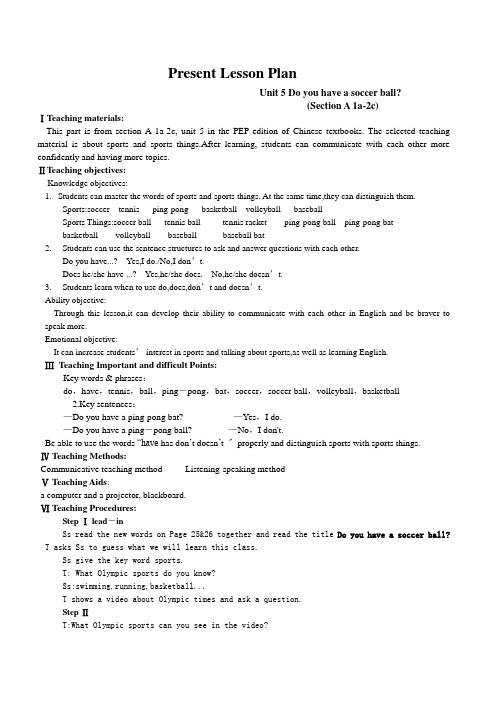
Present Lesson PlanUnit 5 Do you have a soccer ball?(Section A 1a-2c)ⅠTeaching materials:This part is from section A 1a-2c, unit 5 in the PEP edition of Chinese textbooks. The selected teaching material is about sports and sports things.After learning, students can communicate with each other more confidently and having more topics.ⅡTeaching objectives:Knowledge objectives:1.Students can master the words of sports and sports things. At the same time,they can distinguish them.Sports:soccer tennis ping-pong basketball volleyball baseballSports Things:soccer ball tennis ball tennis racket ping-pong ball ping-pong batbasketball volleyball baseball baseball bat2.Students can use the sentence structures to ask and answer questions with each other.Do you have...? Yes,I do./No,I don’t.Does he/she have ...? Yes,he/she does. No,he/she doesn’t.3.Students learn when to use do,does,don’t and doesn’t.Ability objective:Through this lesson,it can develop their ability to communicate with each other in English and be braver to speak more.Emotional objective:It can increase students’ interest in sports and talking about sports,as well as learning English.ⅢTeaching Important and difficult Points:Key words & phrases:do,have,tennis,ball,ping-pong,bat,soccer,soccer ball,volleyball,basketball2.Key sentences:—Do you have a ping-pong bat? —Yes,I do.—Do you have a ping-pong ball? —No,I don't.Be able to use the words “have has don’t doesn’t 〞properly and distinguish sports with sports things.Ⅳ Teaching Methods:Communicative teaching method Listening-speaking methodⅤ Teaching Aids:a computer and a projector, blackboard.Ⅵ Teaching Procedures:Step Ⅰ lead-inSs read the new words on Page 25&26 together and read the title Do you have a soccer ball? T asks Ss to guess what we will learn this class.Ss give the key word sports.T: What Olympic sports do you know?Ss:swimming,running,basketball...T shows a video about Olympic times and ask a question.Step ⅡT:What Olympic sports can you see in the video?Ss:I can see running,jumping,marathon,boxing,soccer and so on.T shows a lot of pictures about sports and sports things,and ask them if they know these sports.For example,a picture of soccer and ask what thing we need if we want to play soccer.Ss answer a soccer ball.And then tennis,tennis ball,tennis racket,volleyball a volleyball,ping-pong, a ping-pong ball,a ping-pong bat,basketball, a basketball,baseball,a baseball and a baseball bat.Step ⅢNew teachingT shows the kind of sports and sports things separately and leads them to read.Sports:soccer tennis ping-pong basketball volleyball baseballSports Things:soccer ball tennis ball tennis racket ping-pong ball ping-pong batbasketball volleyball baseball baseball batStep ⅣT: Do you like sports? What sports do you like?Ss: I like...T: Eric and Tom like sports too. Now,turn to page 25,look at the picture.T: What are they doing?What sports things do they have?Ss answer and do the match work.Ss:Look at picture x,it’s a ...Step Ⅴ1bT:Look at 1b,read the sports things together.Ss read.T:Listen and circle the words you hear.1cSs read 1c together.T shows more pictures and ask Ss to complete two sentences after Yes,I do./No,I don’t.I have a ping-pong bat. I don’t have a ping-pong ball.Ss read them together.Ss guess waht sports things the teacher has and ask questions.Ss: Miss Huang,do you have a ...?T:Yes/No, I have../I don’t have...Step ⅥPracticeSs do pair work,talking about their own sports things.A: Do you have a …?B: Yes, I do. I have a ...A: Do you have a …?B: No, I don’t. I don’t have a ...T asks some pairs to practice.Step VIIT: Look at 2a ,what can you see in these pictures?Ss: Names.T: Why there are names here?Ss:Key word.T: We will finish 2a&2b together.Listen to the tape and Ss answer like this:Number 1, Pau l and his friend are talking about the soccer ball.’s read the conversations together.2c Review the pictures in 2a and answer the questions.Does Jane have a tennis ball?Does Dale have a volleyball?Does Paul have a soccer ball?Does Mike have a basketball?Ss answer with Yes/No,he/she does/doesn’t. He/She has/doesn’t have a ...Ss do pair work.One ask,one answer.T show more pictures about others with sports things,and ss answer.Step VIIIT makes a conclusion.Sports: soccer tennis ping-pong basketball volleyball baseballSports Things: soccer ball tennis ball tennis racket ping-pong ballping-pong bat basketball volleyball baseball baseball batDo you have... Yes,I do./No,I don’t.I have .../ I don’t have..Homework1.Ss try to memorize the sports and sports things of this lesson.2.Ss use “Do you.../Does he/she〞to ask questions and answer.3.Preview 2d.Blackboard DesignDo you have a ping-pong bat/ball? Does he/she have ...?Yes,I do./No,I don't. Yes/No,...Teaching reflectionSs should do more practice,including the words and sentences.They can use their things or others’objects to practice.。
Unit 5 Do you have a soccer ball 说课稿
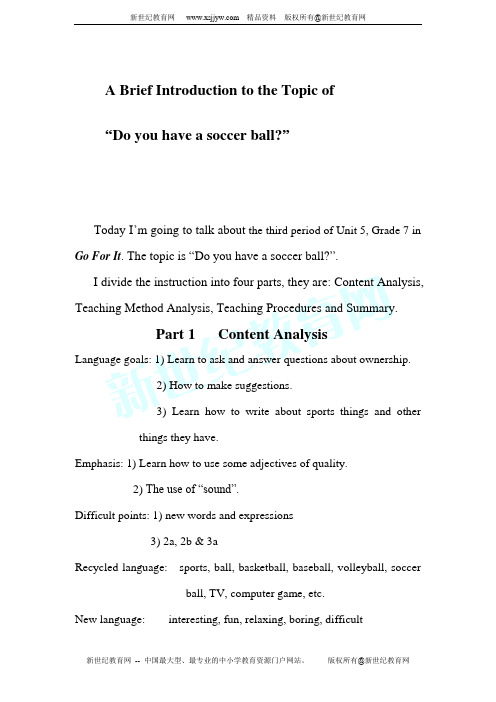
A Brief Introduction to the Topic of“Do you have a soccer ball?”Today I’m going to talk about the third period of Unit 5, Grade 7 in Go For It. The topic is “Do you have a soccer ball?”.I divide the instruction into four parts, they are: Content Analysis, Teaching Method Analysis, Teaching Procedures and Summary.Part 1 Content AnalysisLanguage goals: 1) Learn to ask and answer questions about ownership.2) How to make suggestions.3) Learn how to write about sports things and otherthings they have.Emphasis: 1) Learn how to use some adjectives of quality.2) The use of “sound”.Difficult points: 1) new words and expressions3) 2a, 2b & 3aRecycled language: sports, ball, basketball, baseball, volleyball, soccerball, TV, computer game, etc.New language: interesting, fun, relaxing, boring, difficultlet’s play tennis.That sounds interesting. / No, that sounds boring.Ed Smith has a great sports collection.But he doesn’t play sports- he only watches them onTV.Maybe all the teachers here have got the content. It’s clear that the new words and expressions are not very difficult for our students. But I think it’s still necessary for me to give them enough time to practice, because vocabulary is a very important point for our English learners. They are just like stones and bricks of a house. Without them, students will get into trouble in learning English.(That’s all for Part 1, next I’ll show you Part2)Part 2 Teaching Method AnalysisTeaching Method: 1) Tasked-Based language teaching method2) “Learning by doing, learning by using”3) Students-centered, people-orientedEmotion factors: 1) By describing the ownership of sports things,students learn to enjoy the happiness of having acollection.2) Enjoy the pleasure of communication3) Improve interest of learning English4) Enhance students’ self-confidenceIn this lesson, I will mainly use Task-Based language Teaching Method. I think if I want to improve my students’oral English, I must give them more chances to practice. That is “learning by doing, learning by using”. In this case, I designed a lot of tasks according to New English Curriculum. I will lead my students to study and cooperate with each other. Because New English Curriculum points out that the general aim of English teaching in this stage of Junior Education is to cultivate students’comprehensive ability of using English. I think my teaching methods are in line with the requirement of New English Curriculum.I will also use multi-media. I think, if I want my students to keep interested in English, I must try my best to attract their attention. Multi-media is a very good way to do that. (So much for part 2, le t’s come to the next part –Part 3)Part 3 Teaching ProceduresI design 8 steps in this lesson.Step 1 Group Presentation & Warming--up (5′) First of all, I will ask my students to have a group presentation about their preparation of the lesson. I will greet my students as usual, and encourage them to communicate with me. And let the students feel happy and relaxed in my class.Step 2 “ What’s missing?” Game (2 ′)In this step I will show some interesting pictures to my students. I will ask my students to look at these pictures very carefully and try to find which picture is missing. If they know which picture is missing, they should stand up and tell me loudly. In this way, students will be interested in playing this game, they will review the words they learned and they will feel fun in leaning English as well. The CAI photos and students’ quick reactions may bring us the first high point.Step 3 Drill & Practice (6′)In this step, I will show some pictures of my students and some key words on the screen. The people in the picture are their classmates. I will ask the students to guess what they have. They are supposed to use the sentence patterns like “Does he/she have…?”“Do they have…?”. Because the people in the pictures are very familiar to my students, they can surely arouse the students’ interest of speaking and learning English. And then I will ask them to have a group work to practice “Do you have…? Does he/ she have…?”.I will also add some emotion education here. For example: when my students guess the answers right, such as “ XX has a basketball.” I will talk to the student in the picture: Let’s play basketball! The student maybe will say “OK, that sounds interesting.”Then I will teach them that sharing things with others is a very happy thing. And I will ask themto repeat it. They will be glad to do that.Another important thing for me in this stage is to guide my students to practice in many different kinds of ways. For example, chain-drills, wave-practice, boys and girls, left and right, front and back and so on. Till they become very familiar with the target language. The CAI photos and the changeable practice may bring us the first high point.Step 4 Act & Guess( 6′)In this step, I will use some interesting and exaggerated pictures to teach some new descriptive adjectives, such as: interesting, fun, boring, relaxing, etc. In 1b on page 28, students are supposed to draw pictures and let other students guess what the pictures mean. That is Draw & Guess. I think it will be more interesting to change it into Act & Guess. I will give each group a short conversation like “ Let’s watch TV. ”“ That sounds boring”. I will ask each group to choose 2 students to act the conversation without talking. The other students in the group are supposed to guess the conversation and then all the class read the conversation. I think my students’lively actions and facial expressions will give not only them but also us the joy of speaking and learning English. This will be the second high point of this lesson.Step 5 Listen & Practice (6′)2a & 2b is a listening exercise. It’s the difficult point of this lesson ,too. It mainly trains students to get useful information from listening materials. I will guide my students to finish 3 tasks to breakthrough it Task 1: Listen and check the words that you hear in 1a.First students listen and check the words they hear. This task is quite easy.Task2: Write a word from 1a in each blank.Next students listen again and write a word from 1a in each blank. It’s a little difficult. I will ask my students to do it in pairs. And when checking, I’ll give some necessary explanations too.Task 3 Pairwork (2c)Finally students are supposed to act the conversation in pairs.By finishing the three tasks, most students can master some listening skills and understand the article quite well. And they can also learn how to get useful information from listening materials, how to report and how to cooperate with each other.Step 6Group study ( read, discuss, ask questions and raise problems) (10′)In this step, students are supposed to study in groups. First they read the passage in 3a, and then they discuss about it to ask some questions about the content of the passage. The more questions, the better. And other groups are supposed to answer the questions. Then students are supposed to raise problems . I will ask: Which words or sentences aredifficult for you to understand? Then other students are supposed to solve the problems. If there is a problem that no students can solve, I will give them some help. In this step, students learn to think themselves, ask questions and answer questions themselves , raise and solve problems themselves. By doing this, students can grasp the target language quite well in an expressive and creative way. This will be the third high point of this lesson.Step 7 Writing practice (8′)In this step, students are asked to write their own passages according to the sentence patterns they have just learned in 3a. They can write not only about sports things but also something they are interested in. And then I will ask each group to give a passage and read it together.Step 8 Chant (2′)I prepared a chant about the sentence patterns by a piece of rhymed music. Students revise the target language in a very happy way and the class is over in the fourth high point.Part 4 SummaryIn my class my students are happier and happier. They feel more and more interested in English along with my teaching procedures. Why?Because during my teaching, I always try my best to get my class alive and encourage the students to cooperate and communicate with each other. They listen, talk, read and write. So students in my class can really learn by doing, learn by using. They can not only grasp the target language well, but also increase comprehensive abilities in a very pleasant way.That’s all. Thank you.。
unit5doyouhaveasoccerball全英说课稿
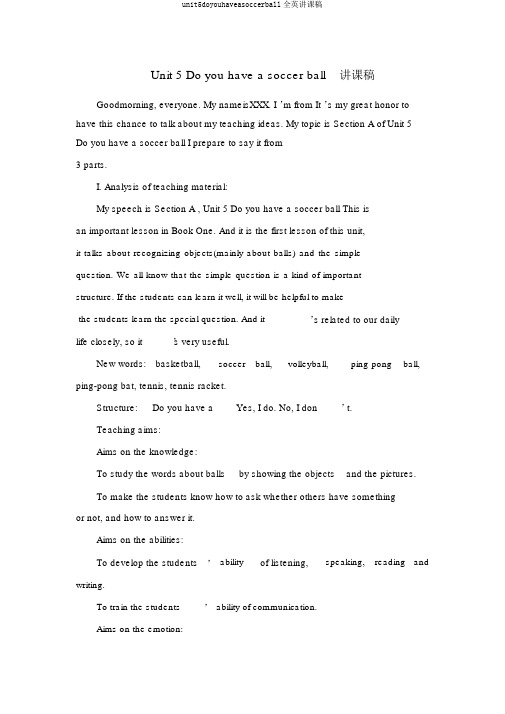
Unit 5 Do you have a soccer ball讲课稿Goodmorning, everyone. My nameisXXX. I ’ m from It ’ s my great honor to have this chance to talk about my teaching ideas. My topic is Section A of Unit 5 Do you have a soccer ball I prepare to say it from3parts.I. Analysis of teaching material:My speech is Section A , Unit 5 Do you have a soccer ball This isan important lesson in Book One. And it is the first lesson of this unit,it talks about recognizing objects(mainly about balls) and the simplequestion. We all know that the simple question is a kind of importantstructure. If the students can learn it well, it will be helpful to makethe students learn the special question. And it’ s related to our dailylife closely, so it’s very useful.New words: basketball,soccer ball,volleyball,ping-pong ball, ping-pong bat, tennis, tennis racket.Structure:Do you have a Yes, I do. No, I don’t.Teaching aims:Aims on the knowledge:To study the words about balls by showing the objects and the pictures.To make the students know how to ask whether others have somethingor not, and how to answer it.Aims on the abilities:To develop the students’ability of listening,speaking,reading and writing.To train the students’ability of communication.Aims on the emotion:To make the students be interestedin good cooperation and competition.To make the students love sports, love life.Teaching key points and difficult points:To master the words and sentences of the lesson.To understand the usage of the simple question.Howto makethe students understand the new language items naturally.How to make dialogues and act them out.II. Teaching Methods1.“Communicative”teaching method.2.“Task- based”teaching method.Everyone knows that the main aims of learning English in middle schoolreading is to cultivate the students ’ abilities of listening, speaking, and writing,and their good sense of the English language. So, in thislesson,I ’ll use the above methods. I think it’ s helpful to develop the students ’ abilities.That is to say, I ’ ll let the students have a better understanding of the key structures.III. Teaching ProceduresThere are 5 steps in my teaching procedures.Step 1. Lead-in.Step 2. PresentationStep 3. PracticeStep 4. SummaryStep 5. Blackboard designNow let ’s watch the first step of the lesson.First, in order to lead in the lesson, I am playing a guessing gamewith the students by using different kinds of balls. I think the ballscan attract the attention of the students and activate the studentsto regard the topic of the lesson.Step 2, Presentation. There are 5 parts in this step.Step 1 Learning new wordsWith the help of the PPT and Whiteboard, they can provide a realsituation to understand the meaning of the words, not by presenting thenew words one by one and telling them the Chinese meaning. So the students can remember the words quickly and naturally.Part 2 Interesting readingIn this part, I'll show students many interesting ways to read thenew words. These ways can arouse the students' learning interest.And they can also help the students master the new words.Part 3 A memory gameThe purpose of my design is to make the new knowledge permanent and makethe class full of fun. Meanwhile, through group works, cultivate the spirit of cooperation.Part4 Self-studyThrough pair works, ask students to learn by themselves. At the same time, encourage students to communicate with each other. By reading and listening, improve their skills. Have a further step to practice thetarget languages.Part 5 Show the knowledge structureThe purpose of my design is to enhance the understanding and mastering of the new knowledge. Meanwhile, It is also in preparation for the following exercise.Step 3 Practice. This step, I'll provide the students somesituations, and then ask them to make conversations. At the same time, by doing someexercises, the students can master the new knowledge. In class, I am aguide, while the students are the center. I just join them,giving suggestions, and offering help when they need.Step 4, Summary. Ask the students to sum up by themselves in orderto train the skill of summary and the cooperation consciousness.Step 5, Blackboard design. I'll ask the students to write the new words and sentences on the blackboard. On one hand, it can check the studentseffects of learning, on the other hand, It can present the knowledgestructure. The design will emphasize the key points of the lesson. Andthen, show the homework to the students, meanwhile encourage them to take exercises in order to keep healthy.Above all is my hope you can give me some suggestions. Thanks foryour listening.。
Unit5Doyouhaveasoccerball说课稿
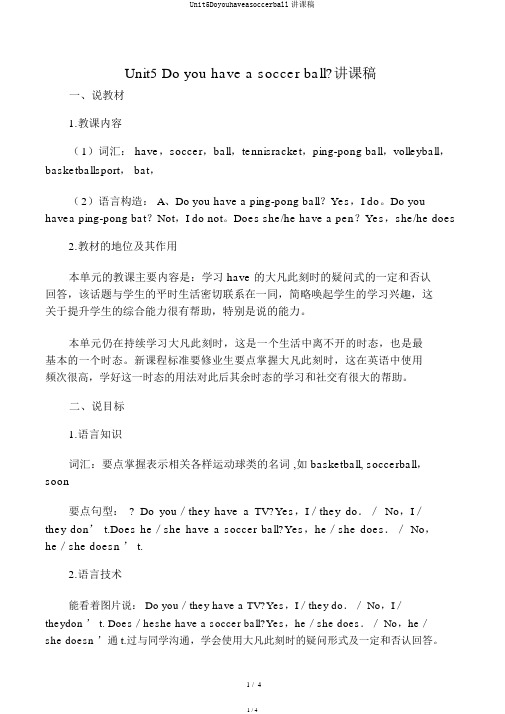
Unit5 Do you have a soccer ball?讲课稿一、说教材1.教课内容(1)词汇: have,soccer,ball,tennisracket,ping-pong ball,volleyball,basketballsport, bat,(2)语言构造: A、Do you have a ping-pong ball?Yes,I do。
Do you havea ping-pong bat?Not,I do not。
Does she/he have a pen?Yes,she/he does2.教材的地位及其作用本单元的教课主要内容是:学习 have 的大凡此刻时的疑问式的一定和否认回答,该话题与学生的平时生活密切联系在一同,简略唤起学生的学习兴趣,这关于提升学生的综合能力很有帮助,特别是说的能力。
本单元仍在持续学习大凡此刻时,这是一个生活中离不开的时态,也是最基本的一个时态。
新课程标准要修业生要点掌握大凡此刻时,这在英语中使用频次很高,学好这一时态的用法对此后其余时态的学习和社交有很大的帮助。
二、说目标1.语言知识词汇:要点掌握表示相关各样运动球类的名词 ,如 basketball, soccerball,soon要点句型:? Do you/they have a TV?Yes,I/they do./No,I/they don’ t.Does he/she have a soccer ball?Yes,he/she does./ No,he/she doesn ’ t.2.语言技术能看着图片说: Do you/they have a TV?Yes,I/they do./ No,I/theydon ’ t. Does/heshe have a soccer ball?Yes,he/she does./ No,he/she doesn ’通t.过与同学沟通,学会使用大凡此刻时的疑问形式及一定和否认回答。
unit5Doyouhaveasoccerball说课稿
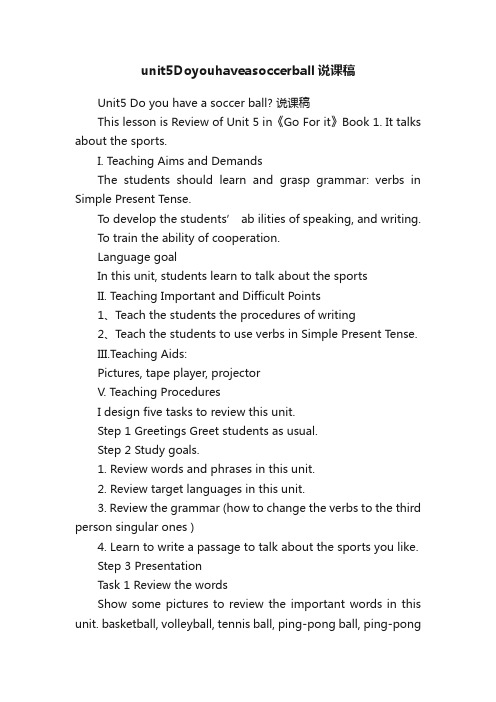
unit5Doyouhaveasoccerball说课稿Unit5 Do you have a soccer ball? 说课稿This lesson is Review of Unit 5 in《Go For it》Book 1. It talks about the sports.I. Teaching Aims and DemandsThe students should learn and grasp grammar: verbs in Simple Present Tense.To develop the students’ ab ilities of speaking, and writing.To train the ability of cooperation.Language goalIn this unit, students learn to talk about the sportsII. Teaching Important and Difficult Points1、Teach the students the procedures of writing2、Teach the students to use verbs in Simple Present Tense.III.Teaching Aids:Pictures, tape player, projectorV. Teaching ProceduresI design five tasks to review this unit.Step 1 Greetings Greet students as usual.Step 2 Study goals.1. Review words and phrases in this unit.2. Review target languages in this unit.3. Review the grammar (how to change the verbs to the third person singular ones )4. Learn to write a passage to talk about the sports you like.Step 3 PresentationTask 1 Review the wordsShow some pictures to review the important words in this unit. basketball, volleyball, tennis ball, ping-pong ball, ping-pongbat, soccer ball, baseball, baseball bat.Task 2 Review the phrasesAsk students to translate the important phrases in this unit.Task 3 Target LanguageShow a sample for students and ask them to make similar conversations. A: Do you have a volleyball?B: Yes, I do.A: Where is your volleyball?B: It is under my chair.A: Let’s play volleyball.B: That sounds fun.Task 4 GrammarFirst, show a video to teach them how to change the verbs to the third person singular ones and how to use verbs correctly in Simple Present T ense.Then, finish exercises to consolidate the grammar.Task 5 Writing假如你是Tony,你在Green Middle School上学,请你写一篇短文介绍你和你的朋友喜欢的运动及其原因。
- 1、下载文档前请自行甄别文档内容的完整性,平台不提供额外的编辑、内容补充、找答案等附加服务。
- 2、"仅部分预览"的文档,不可在线预览部分如存在完整性等问题,可反馈申请退款(可完整预览的文档不适用该条件!)。
- 3、如文档侵犯您的权益,请联系客服反馈,我们会尽快为您处理(人工客服工作时间:9:00-18:30)。
英语说讲课稿件
我要讲的内容是Section A , Unit 5. Do you have a soccer ball
这是七年级上册书里很重要的一部分,我要讲的内容是本单元的第一课。
在这一课里,我要带学生们学习如何辨认物体,主要是认识体育方面的球类运动,以及掌握简单的问句。
学生在二单元里面已经学习了如何用yes和no来回答简单的问题。
但是,在这个单元里,我们将要学习到不一样的内容。
我们知道,简单问句虽然简单,但却又不简单,如果学生可以把简单问句学好的话,那将对他们学习特殊问句有很大的帮助,而且,简单句与我们的日常交际息息相关,所以,学好它非常重要。
这一课的新单词有: basketball, soccer ball, volleyball, ping-pong ball, ping-pong bat, tennis, tennis racket.
主要句型: Do you have Does he /she have
教学目标:
通过看图片,学习有关球类运动的单词
教会学生询问某人是否有什么东西以及怎样去回答有还是没有
能力目标:
培养学生的听说读写能力。
训练学生的交流能力
情感目标:
⑴.让学生学会团队合作⑵让学生热爱运动、热爱生活
教学重点难点:
如何让学生很自然地接受新语言
如何让学生学会团队合作
如何激发学生学习英语的兴趣
如何编造对话和表演出来
我要采用的教学方法
1.交际法
2.任务型教学法
学习方法
首先,看、听、说,获得语言能力
然后,团队合作,一起探究。
学生为中心,我只起引导作用。
教学步骤
Step1. Warm-up.
用一些简单的问题向学生提问,检查一下他们是否记住了以前学过的内容。
例如,What's this Spell it, please.
What color is it
Is this your pen
Is that your backpack and so on.
Step2. Presentation.
拿出一个乒乓球问学生,What's this
为什么要拿乒乓球呢,因为它是一项简单的并且在我们国家开展最广泛的运动。
.
2. Leading in new words : 我会放一些幻灯片。
足球,排球,乒乓球比赛,和一个篮球图片
3.教对话:
让一个学生来完成示例对话。
给他看乒乓球,然后进行对话:
T: I have a ping-pong ball. Do you have a ping-pong ball (Here, you may help him answer "Yes, I do." or "No, I don't.")
S: Yes, I do.
4. Practice: 分角色来阅读对话. 之前,必须给她们讲清楚怎样去做,让他们去问自己的搭档有什么球
5. Groupworking and competition:把学生分成若干个三人小组,并给他们例子
A: Do you have a basketball
B: Yes ,I do. A: Does he have a basketball C : Yes, he does.
6. Listening
听录音然后圈出听到的单词
It's Activity 1a.
Blackboard design:
Ping-pong ball /bat Do you have a ping-pong ball
Soccer ball Yes, I do./No, I don't.
Basketball
V olleyball Does he have a soccer ball
Tennis racket Yes, he does.
Does she have a volleyball
No, she doesn't.。
